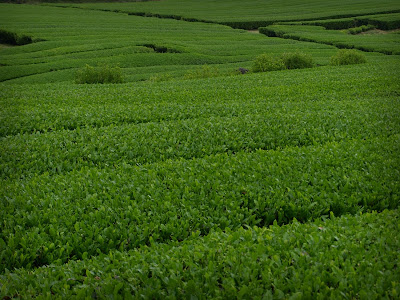
When we've made our way down to Jeju in the past two years, we've always had one thing on the agenda, beach time. Now, where better to sit on the beach than at a world famous, unusually long (560 m), surfer-loving, tourist infested, fine white sand beach
? Jungmun, rated the best beach in Korea, fits this perfect description of a beach. Why wouldn't you want to give it a try
? Trev and I, on the other hand, can give you about five thousand reasons why we would rather not go to Jungmun. However, the best reason of all is that right beside this world famous beach, just around a cliff and little to the east lays a beach that has no name... and, a beach with no name means a beach with no people. On our last two trips to the island, we have spent a considerable amount of time sitting on our wonderfully relaxing, un-named beach.
One thing that we do know about this beach is that it has a peculiar type of sand, Jinmosal or Jin sand. This special sand is neither white nor black but is multicolored. It is technically considered to be black, red, white and grey and is unique in and of itself.

And, while the sand itself is fascinating, the scenery surrounding beach is equally as beautiful. A little farther from the water and a little closer to the cliffs, the upper beach is strewn with Jeju's Hyeonmuam stones, which you can see above, and crazy cylindrical lava-tube rocks, which we posted on last year. See the post,
Volcanic Remains.

During the day as we sat, had a picnic and watched the tide go in and out we were amazed to see brightly colored orange balls floating about 200m out from the shore. There were roughly 20 these little spheres bobbing around in the salty water and over a period of three hours we watched as they slowly made their way down the beach. Throughout the afternoon we were speculating as to what they were or what they were doing until we remembered that Jeju is famous for three things: Stones, Winds and Women.
So, to answer the question, the orange balls that we were seeing were empty gourdes, called Taewak. And, why were they floating around in the ocean
? These gourdes were supporting one of Jeju's greatest sights, diving women, or Haenyo, to be exact. The older generation of Jeju's women are famous for diving to depths of up to 20m and staying under for over 2 minutes without a breathing apparatus and all to make a living. And, when they finally do come up for air it is the gourdes that support their weight and provide them with a short break from treading. These Haenyo women catch everything from abalone to octopus. Then, after this long day of foraging, they sell their goods along the roadsides. Talk about a long day!

We loved 'our' little secluded beach just as much the second time as we did the first. And, it's almost Jungmun Beach, it's so close, yet it's so much better!
 As keeping with tradition, here is a list of the top 5 things we will be most happy to return to:
As keeping with tradition, here is a list of the top 5 things we will be most happy to return to: As keeping with tradition, here is a list of the top 5 things we will be most happy to return to:
As keeping with tradition, here is a list of the top 5 things we will be most happy to return to:













































